Aryna Sabalenka's Skewed Backhand
Iga Świątek 7-5, 4-6, 7-6(7) Aryna Sabalenka – Madrid Final Analysis
There was a lot to unpack from yet another classic final between Iga and Aryna in Madrid, so the focus of this piece will be on a few finer details. This will mostly cover Aryna’s scorching BH, from its ins and outs to the ways in which it worked for and against her.
Aryna’s BH setup
Aryna has a heavy, and often lethal, BH stroke. Slightly different to some other great BHs, though, is the emphasis on accelerating from a high power position. If we compare her stroke with Elena Rybakina’s, both assume great power positions (upright racket tilts) but Aryna pushes it that fraction further up and even back over slightly.
The upright power position is perfect for gravity-assisted racket head acceleration. Unlike Elena, though, Aryna coils it back just a little further (hence higher racket position and lower head) for a more extreme drop and transfer through to contact, whereas Elena executes one continuous, rounded motion.
You can see by their arm bends at the racket drop, or lack thereof in Aryna’s case, that she drives harder with her arms from that power position. Elena, instead, continues to rely on gravity to do more of the work for her with her double arm bend and loosened wrists that see the racket drop further down into ‘the slot’ to complete the circular motion.
Because she cuts straight to a pretty vertical drop of the racket head, her swing isn’t actually too big compared to others who would continue to round out their swing behind them.
Other important aspects to note are that she doesn’t close the strings when the racket reaches its lowest point, so it’s a very flat-hitting swing path where topspin is more likely, if at all, to be created at contact by the work the left hand does going over the ball with her choked-up grip.
You can see that choked up grip below, compared to Elena who doesn’t do the same, hence the space at the top of her grip.
This is also reflected in the racket’s angling after contact as it falls on the right side of the ‘V’.
The higher left hand usually offers a bit more leverage over the racket head, and is associated with more left hand feel, although how heavily Aryna drives her swing from back to front mitigates that effect somewhat.
The footwork is also a major player, here. Her default is to sync up her weight transferral so that she accelerates the racket as she moves forwards onto her front leg.
Although it’s slightly obscured, here, watch how Aryna doesn’t plant down her right foot until she begins accelerating the racket head downwards. Doing this, even with a very minimal shift into that right foot, means she’s always transferring all of that focused energy forwards into the ball.
This adds to the build up of tension by loading the back leg and the racket high for a huge, simultaneous unravelling.
It’s slightly more exaggerated than most, including Rybakina’s where her swing motion will more frequently act a little more independently from the timing of her footwork. There is weight transferral but her planting of the feet is there to provide a steadier base to lean on, which can be something Aryna’s BH lacks.
What also sets hers apart from others and, as we’ll see, can sometimes work against her is that she plants and shifts in a semi-open stance the majority of the time. Her right foot is often planting forwards to the right of her back leg, rather than across to close up her body.
This can create a bit more room close to body, which, combined with her gravity-assisted swing motion and minimal planting forwards, means she’s great at absorbing pace that comes directly at her. It’s often how she handles playing inside-out/down the line the best.
There is, however, a trade-off in the way she’s often quick to pull back in onto her right foot after striking the ball, because that’s where her centre of gravity then is. Even when she plants across, Aryna either doesn’t bring her leg further across, meaning the fallout of her shot is still back towards the middle of the court, or she initiates the shift quickly into that plant off of her left leg, meaning she’s not actually resting on her right leg during the fallout.
When absorbing pace to redirect down the line or inside-out, she does so with more ease because less is, quite literally, resting on the right leg’s planting, but when that pace isn’t there or she’s pushed wider, she doesn’t give herself a crutch to lean on so that she can suspend herself in that outwards direction.
To emphasise: the important detail here is the two-step shift. With the heavy swing, as well, it’s difficult to guide this down the line despite the opportunity to.
A player whose technique is almost the inverse of Aryna’s, and is therefore a good point of comparison, is Mirra Andreeva. She always looks to close up her body with a big right foot plant across geared towards falling out onto her left leg, and so the down-the-line shot has been her trademark, and its precision has helped account for her raw power deficit.
With a smaller take-back and more natural racket drop, too, she does most of the unravelling once she’s planted that foot in front, similar to how Aryna moves through the gears once she’s coiled back onto her left leg but with more ease because Mirra’s not shifting her upper body too heavily through the ball. As a result, she’s able to lean on that crouched right leg for an extended period. You can even track this just from how her right foot starts angled to the left and ends up rotating almost 180º by the end of the fallout.
The sticking point here is how easily Mirra fields that line ball and how comfortable she is dishing it out against with a lack of pace when going that way. Aryna’s relative inability to do the same proved, in the above instance, that she’s too stunted in her motion to be able to direct that ball further towards the outside.
So, with the gritty details out of the way, here’s what it meant for the actual match itself.
Protecting the forehand
The key all match for Iga was protecting her forehand on the +1s. When you play against the world #1, you need to be aggressive and you need to angle that aggression towards her FH corner, because she’s ill-equipped to counterpunch you on that side.
If you can get her rushing to defend her FH corner on her +1, you’re likely going to then get a ball with the sort of length and bounce that will sit comfortably for you to continue to attack.
The reason for this is Iga’s quite rapid FH motion. It’s compact by way of it being close in to body but still has a lot to get through and is heavily geared towards accelerating through to contact.
Whilst I mentioned Aryna’s BH does just this, in terms of acceleration, her stroke is still very simple and unfolds as such, she just adds an extra bit of oomph to her strokes, so absorbing pace is not an issue. In Iga’s case, she has to time the start of her stroke to meet the ball at the right time, and because she’s doing so in a way that strikes at the ball, she’s not using its pace.
If you compare this with someone like Djoković, whose chain doesn’t actually look miles away from aspects of Iga’s, he unravels at more of a singular pace, focusing his efforts on absorbing the ball’s pace. Being less tucked-up in the beginning also allows him to find the outside of the ball with more ease.
Novak has a much higher elbow start but still with a neutral wrist, so he uses it for a gravity-assisted motion which ends with very little change in acceleration once the racket face closes. You can see below how Iga’s more extreme racket position prior to accelerating into contact requires more force than Novak with his looser wrist, as well as how each finishes, with Iga’s speeding across towards her waist versus Novak’s relaxed over-the-shoulder finish.
Of course, grips heavily influence this. Novak’s semi-western gives him more leverage behind the racket than Iga’s western does, so the need to accelerate to create that leverage is more necessary for Iga than it is for Novak. If she mirrored Novak’s motion with her western grip, she’d be more likely struggle more to absorb the pace of the ball because of that lack of leverage, along with a tighter range of wrist motions, which would make it difficult to keep the racket face square and sturdy. That said, the speed of Iga’s motion is still more extreme than others who have the same grip.
Another reason why that’s preferable over the BH+1 is because Iga’s defence on that side is far superior. She has much easier time using her shorter stroke on that side, along with her open-stance slide, defending that corner and taking her opponent’s time away with her cross court response.
1st set
Iga served extremely well in the opening set. She hit her spots as well as she did all match, especially on big points, and consistently pried weak returns out of both the FH and BH of Aryna.
On 1st serves, the FH was the target – 18/23 were directed towards it, and she ended the match fielding 79.5% (62/78) of them to that wing. Aryna was guilty of playing with margins that were far too low to begin with, leading to an array of flattened responses into the net against serves she had her racket firmly onto. So, going for the less stable wing was paying dividends for the Pole.
The reason for avoiding the BH, beyond the above, is also because of how easy it makes life for Aryna if you feed the BH pace. There was a glimpse of it, here, from one of the few 1st serves she fed Aryna.
Particularly since Iga’s not a consistent spot server, most of her serves into that wing would likely fall right into the Belorussian’s strike zone, so it was asking for trouble. With Aryna’s ability to shorten the swing on return, as well, it would only be a matter of time, then, before she used the pace with her settled footwork against it to direct it into the FH with more potency.
While she managed to win 3/5 of her 1st serve points that were directed into the BH in the 1st set, those 3 (/16) only contributed to 18.8% of the points she won behind her 1st.
Most of the time when Iga went into this side with 1st serves, it was to switch it up, which sometimes caught Aryna cheating to her FH side.
It was the polar opposite when it came to 2nd serves, however. 80% (12/15) of 2nd serves in the opener were aimed at the BH. This is where she was able to handcuff Aryna, somewhat. Even with its erraticisms, the FH is too dangerous to afford ample time as Aryna would inevitably be able to attack the FH corner against it. This not to say Aryna has issues generating her own pace on the BH but it did exploit her movement on return and how that wing lends itself more to shots angled towards Iga’s BH.
This is a common example of Aryna’s approach to meeting the serve. She has a wide base and performs a small split step but never with the intent of propelling into either direction to shift her weight forwards into the shot. If it’s wide enough, she will lunge but when she can make contact from her base or close to it, she will mostly just alter her body angle to do so.
For comparison’s sake, see Sinner’s typical return move. He always shifts his weight wide into either direction, which helps him to use the pace and direct it very easily.
By shifting his weight forwards and suspending himself during contact, he’s able to rely less on the swing to generate anything, allowing him to focus his racket on directing the ball where it needs to go.
Aryna, from her more static position, is instead more at the mercy of her natural swing path. This is especially the case because of the aforementioned left-handedness of it. Sinner is another player whose BH is quite left-handed but his above movement on return overcomes the default issue, which is that your swing path naturally comes more across your body when your non-dominant hand is leading. This is why players with these BH techniques can suffer vs ad-sided kickers because it’s very hard to direct the ball down the line in their open stance since their left arm is taking the strings away from that direction.
With Aryna keeping her right leg firmly inside, like for rallying groundstrokes, and not being pushed across like Jannik’s, she is naturally pulling her body back inside, so it’s, again, difficult to lean on that ball to be able to focus on directing it into the FH corner from either side.
This is another example but from the deuce side.
The kicker serve on clay doesn’t make it easy, either – it really marooned Aryna at times if she wasn’t deep enough to let the ball drop, which was often the case. Again, though, her right leg being tucked in limited her outwards reach to the ball and gave her nothing to rest on. The left-handedness of the swing technique naturally had the same effect of pulling her inside, and also gives her a smaller window of time where they’re even facing the opposite corner.
An arguable adjustment would be to drop deeper to let the ball drop since Aryna can generate great pace off that wing, but it’s less advisable when considering her aforementioned problems with regards to resting/planting on the right leg to hit that space, and her resulting court position. Even if it were to force a weak FH, Aryna, as Elena exploited plenty of times in their semi-final, can struggle to control her swing when dealing with shorter balls.
Now, this is not to say the Italian’s way is the way, but it is a way.
Iga herself is also capable of pulling off big inside-out returns from here.
Iga is more similar to Aryna in terms of smaller shifts and does so with such incredible agility. The key here is that she gives herself a base that angles herself out to the left for contact, and, despite not planting her right leg across the ball, still suspends herself forwards through contact. She’s then able to use her compact, more horizontal swing path to direct the ball down the line.
In the earlier example of Aryna from the other side, her feet prior to contact are too parallel to allow her to push off in the direction of that space.
By the end of the 1st, 2nd serves into the BH contributed to 77.8% (7/9) of the points won behind that serve overall.
The kicker caused particular trouble on the deuce side, where Aryna couldn’t get over the ball in the same way she could on the ad side to at least press Iga’s BH on the +1.
She was, at best, producing weightier inside-ins that she still couldn’t get a wrap on to force more towards the BH corner. The only one she managed to do that on was the singular 1st serve she received on this side (shown earlier).
Otherwise, the standard threat of the slider into the FH meant she was clutching at straws to try and get over to the ball and over the ball itself at contact, leading to a handful of choked-up inside-out returns that carried no real threat of their own.
This was the only one that landed in the ‘red zone’ but didn’t come close to rushing the FH. It was only the awkward timing against the high bounce that led to an error in just from Iga, allowing Aryna to then flip the rally by rushing the FH off the ground.
The ad side was a similar story in terms of getting telegraphed responses well away from threatening the FH corner.
All that being said, this wasn’t completely fatal in the opener. Aryna was winning her fair share of these points (7/17) because she was finding the BH and was overpowering her in those BH rallies since Iga hadn’t yet got going with regards to her timing on that wing.
This was another instance of Aryna being drawn into the BH cross court return but overwhelming that side in the subsequent rally.
What this example highlights is how big Aryna takes that ball cross court, even when faced with a potentially awkward central ball that she has to make room for. Her approach is so well-suited to clamping down further on that cross court ball.
With such heavy power being generated, she’s able to get at Iga’s BH swing, which applies forced acceleration in a similar way to how her FH does, meaning that side isn’t one that absorbs pace, either. Its precision, when at its best, is in a world of its own, but such is the way she times the start of the stroke to get the racket back to complete a compact burst into contact, that she’s attacking the ball rather than using the pace of it.
Very different from both Elena’s and Aryna’s strokes, Iga starts with more outside the line of the ball with strings already closed, but gets it back inside with a more horizontal coil to then burst through to contact. The compactness makes her hard to rush and she be so dangerous when given time, but because she’s hitting out at the ball with her own force, she’s unable to use the pace of the oncoming ball in the way Aryna and others are able to.
This tightened things up a bit for Iga early on because, without the right timing to keep Aryna at arm’s length, she was having to play too much catchup, which her shots don’t afford her the luxury of, especially not against power-hitters as big as the world #2.
Iga’s best form of escape was to force mistakes the best she could. The point below illustrates not only that but how good the BH’s corner defence is, as she buys herself so much time through just her movement, sliding and the compactness of her stroke, enabling her effectively find the outside of the ball to counter through the same short angle.
This made life difficult for Aryna given the aforementioned issues when the opportunity presents itself to take the ball line. Even though she has pace to work with, here, that subtle left foot-right foot shift into the right foot’s plant acts as a collective push into the ball that doesn’t give her enough of a window to comfortably guide the ball towards the space.
2nd set
Not a mass amount changed in the 2nd set besides a natural tipping of the scales.
Iga’s spot serving cooled down, as expected, and so did her serve speeds (dropping off a few mph’s). Aryna took full advantage of this with growing consistency behind the FH return, as 18 more (/21) 1st serves were fed into the FH.
The #2 seed added plenty more margin to those returns this set, using far greater net clearance at times and adjusting her feet well to create ample room in order to get fully behind the ball. That was what earned her the break for the set. There was even a far better lean-on BH down the line winner involved for good measure.
Iga was still struggling off the ground, somewhat, as well. She missed some gilt-edged opportunities against short balls, particularly on the FH where she was lacking drive behind the shot. So, Aryna finally making her play out more of the rallies was paramount to preying on her lack of rhythm.
Aryna also raised her 2nd serve game. She fed Iga a lot of wide serves, pushing the lines well at times, and striking so well from the ground so as to hit the open space much more effectively than in the opening set. Rushing Iga’s high return position was something she’d struggled with but managed to execute much more ruthlessly in the 2nd, including using a lot of good flat 1st serves into those areas, too.
Not much even changed from the 1st set’s patterns into the BH. All of the 2nd serve points Iga won (5) resulted from finding the BH return, but with a higher 1st serve % (up 5% to 66%) due to higher percentage serving, she was forcing herself into feeding Aryna’s FH more often.
3rd set
Off the back of those reduced figures into the BH, there was perhaps an argument to be made that some 1st serve kickers as a change-up to catch Aryna more by surprise would’ve been a good play. And, while it might’ve been, Aryna showed exactly why it would still eventually prove a dangerous angle of approach, especially with the wide ad/T deuce spot serves going absent from her arsenal.
Aryna claimed the first break of the set again right off the back of finding Iga’s FH corner twice in a row from 30-30 in the 4th game.
The first was pretty influential to Iga’s overall approach to 2nd serves on the deuce in the decider, as Aryna was beginning to run around more and more of these serves when they weren’t close enough to the lines to force her hand.
It wasn’t a deep return but it came through with enough pace to have Iga scrambling to get across, leading to an error.
Iga then paid the price for the 1st serve into the BH, as she did for the initial break in the 2nd set. Aryna, here, used the pace to deflect the serve into that ‘red zone’. Another tentative bit of FH acceleration allowed the #2 to really go after the follow-up FH, before teeing off towards the other side against the resulting weaker balls.
It forced a significant change in approach from Iga on serve for the rest of the set. With pressure being mounted to push the lines to find the BH on the deuce, a couple of double faults were induced during the decider, and she was made to tilt her search for the BH almost entirely towards the ad side.
It was easier to kick the ball out to find the BH on the ad, especially since Aryna would have to expose more of the court to run around it and would find it even harder to directly attack the FH corner from there.
13/29 (44.8%) of Iga’s 2nd serves into the BH in sets 1-2 came from the deuce side, but just 4/17 (23.5%) of them came from the deuce side in set 3.
The rate of BH returns against 2nd serves fell as a whole, too. The figure hadn’t fallen below 80% off the back of either set, but in the decider only 53.3% (9/16) found their way to that wing.
Subsequently, a lot of Iga’s serves were going straight into the FH. With a bit more juice back on them but also a lot of care taken to avoid giving Aryna FH returns that she could easily lean on, she was able to ask the utmost of her opponent to maintain focus in both her footwork and timing to be able to attack that FH corner.
On top of this, the early break had set off some alarm bells with regards to the FH. Iga started to lift her level on that wing. As the set progressed, her acceleration behind the cross court ball in particular grew in weight, and it allowed her to topple a lot more of the deuce court trades that she had been playing catchup in. So, even when Aryna was finding the FH with good depth, any let-up in the rally was ready to be severely punished.
In this game, where scoreboard pressure could so easily have gotten to her, she held to love off the back of four consecutive serves into the FH.
The big moments
*5-6
It was a bit of a different story when she served to stay in the match for a second time as some cracks started to reappear in her groundstroke timing that led to a match point for Aryna.
Iga’s tried-and-true BH targeting on the 2nd serve paid off, though, as it was able to keep Aryna away from the FH and forced her into a middling return that Iga could use to hit the space with.
It was actually the type of routine point that Aryna had curbed to get to 30-30 in the game by running around the ad kicker.
With that snap timing Iga has to her strokes, even just the panic caused by the threat of a bigger FH strike and the situation itself over the real depth of the shot can be cause for mistimes.
Aryna going for gold, as she’s sometimes guilty of doing a little too often, helped Iga out, though.
Still not out of a sticky spot yet, Iga found her best FH gear again when it mattered most.
As is ever the case in the business end of these big matches, Iga took very little risk when it came to her 1st serve. She notched that % up another few points to 69% in the bruising deciding set. Here, being able to force the body serve made it that bit harder for Aryna to do immediate damage with her return to the FH, not least because she had subtly cheated across and therefore was made to split step back out before contact.
The FH+1, unlike in earlier instances, was swept aside like it was nothing. Full commitment to the swing and the footing behind it. Aryna asked the question, Iga answered emphatically.
At the following point, some slightly tighter footwork from Aryna off another serve into the FH just tested Aryna’s own mettle, but she didn’t quite pass the test.
As discussed with regards to the BH, the FH returning is similar. There are subtle adjustments but Aryna will only shift heavily towards the ball when it slides into the strike zone. Here, static footing after her split-step during the ball’s contact for the serve, left Aryna rooted and reaching. Iga’s FH prowess took over from there.
Then, to finally survive the game, a risky body serve into the BH led to a sketchy BH+1, but the shortness of the resulting ball was in and of itself a hurdle Aryna’s flat groundstroke couldn’t overcome.
Once again, that heavy plant forwards with quite a narrow base, since the right foot plants in line with the left, made it difficult to maintain balance during the shot. As well, the big, up-and-down and flat swing path makes it harder to control the length and net clearance.
Tiebreak
There were three mini-breaks in the breaker and all tied heavily into key motifs of the match.
A slightly wider, more lenient 1st serve into the FH at *3-3 allowed Aryna to show the dangers of straying from meticulous body serving.
She shifts nicely, here, to open up her body and swing freely back across. She didn’t just rest on where she initially landed. As a reward, she was able to attack the FH and close out the point from there.
Iga was quick to respond by rushing the BH on the +1 with another precise BH return, but this time going quicker and lower over placing it deep.
With neither the back leg nor the front leg planting far enough out to give her leverage behind the ball’s path, and the speed of the return rushing the take-back, she had very little balance, and therefore, control over the redirect.
Pressuring the BH+1 was something Iga had gotten plenty of success with in the match when she could rush the movement across. She even did so earlier to break back.
It further highlighted Aryna’s struggles to play the basics on the backfoot, like Rybakina had done in Stuttgart to comfortably stave off this sort of return pressure.
What Elena does here that’s key to defending is planting her outside leg out to the line of the ball. It gives her the platform she needs to get her body behind it as the swing naturally unravels.
Simple, percentage +1 shots like these have been extremely effective from Elena in recent clashes against Iga and Aryna, including in the Madrid semi-final. Using wide serves to open space and acknowledging the quality of a return with simple, early +1 takes has allowed her to rush the pair on their own +1 shots very effectively.
It’s something Aryna largely failed to do outside of the extremes where she was able to attack the ball in a low-percentage manner because she was afforded the time.
After Iga managed to jam up the FH with her 1st serve one last time at *7-7 to hold serve, the match ended on another BH+1 error.
Another quick BH response against a good wide serve, this time leading to a short ball +1 that Aryna could attack, but it only served to highlight the razor thin margins she tends to allow herself in these moments when she takes the ball line.
By planting her front leg inside of her back leg on a ball that’s coming across her body to the outside, she limits not only her ability to lean on the shot but also to reach for the shot, as she’s instantly being pulled back inside away from contact onto the tucked-in right leg.
With the flat of her heavy strike increasing the difficulty of applying margin to the ball with regards to spin, she had little control over the ball to prevent the big vertical strike from flying too close to the sun again.
It was a narrow miss. Not her first but, ultimately, was the most costly one.
Outro
There are plenty of things you can point to that tilted this match one way and then the other – plenty of which I’m sure I didn’t even get into – but Aryna’s BH and Iga’s funnelling of it with her serving strategy paid off in a huge way when it came down to saving match points and breaking in the tiebreak.
In the end, the 17 points Iga won on 2nd serve after finding Aryna’s BH contributed to 81% of the 2nd serve points she won overall. And, had she been a bit more ruthless with some routine FH+1s – including all 5 points she lost when Aryna scratched the surface of the pictured red zone, despite scarcely rushing her in the process – her 58.6% 2nd serve win rate into the BH and 51.2% overall would likely have been a chunk higher.
As the return maps indicate, it did a more than effective job of protecting that corner. Combined with those BH line shots that Aryna struggles to rest on, so could rarely simply guide it down the line or inside out to bruise the FH wing with good margins, Iga was able to mitigate the damage being done as she played her way into an eventually-devastating rhythm.
Against practically any other player on tour, these tiny creases and trade-offs in an otherwise wholly effective groundstroke setup go unexploited, but that’s what makes these the best matchups – everything gets put under the microscope. When two players are performing at as high a level and mirroring each other as much as they did, particularly in the decider, it makes sense for these minutiae to make the difference.
~
Thanks for reading, I hope I managed to do the match of the year justice. You can find me here.







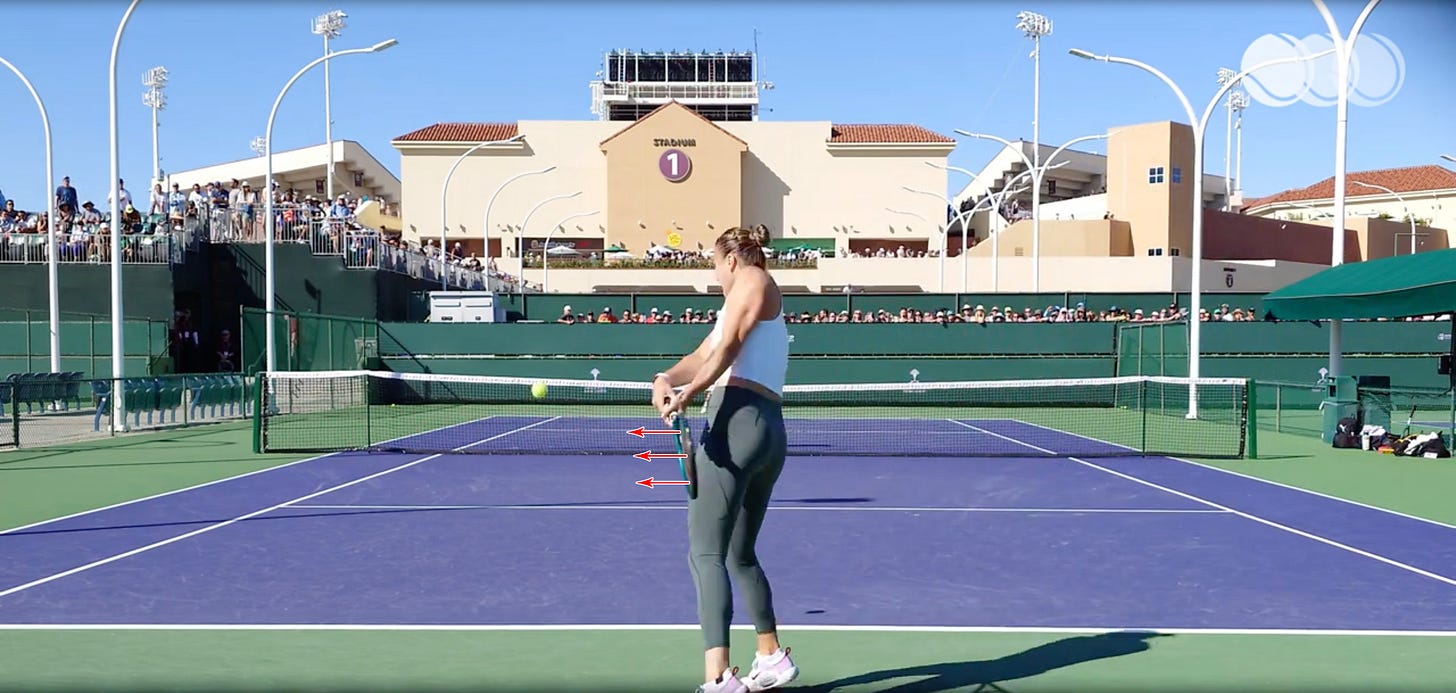
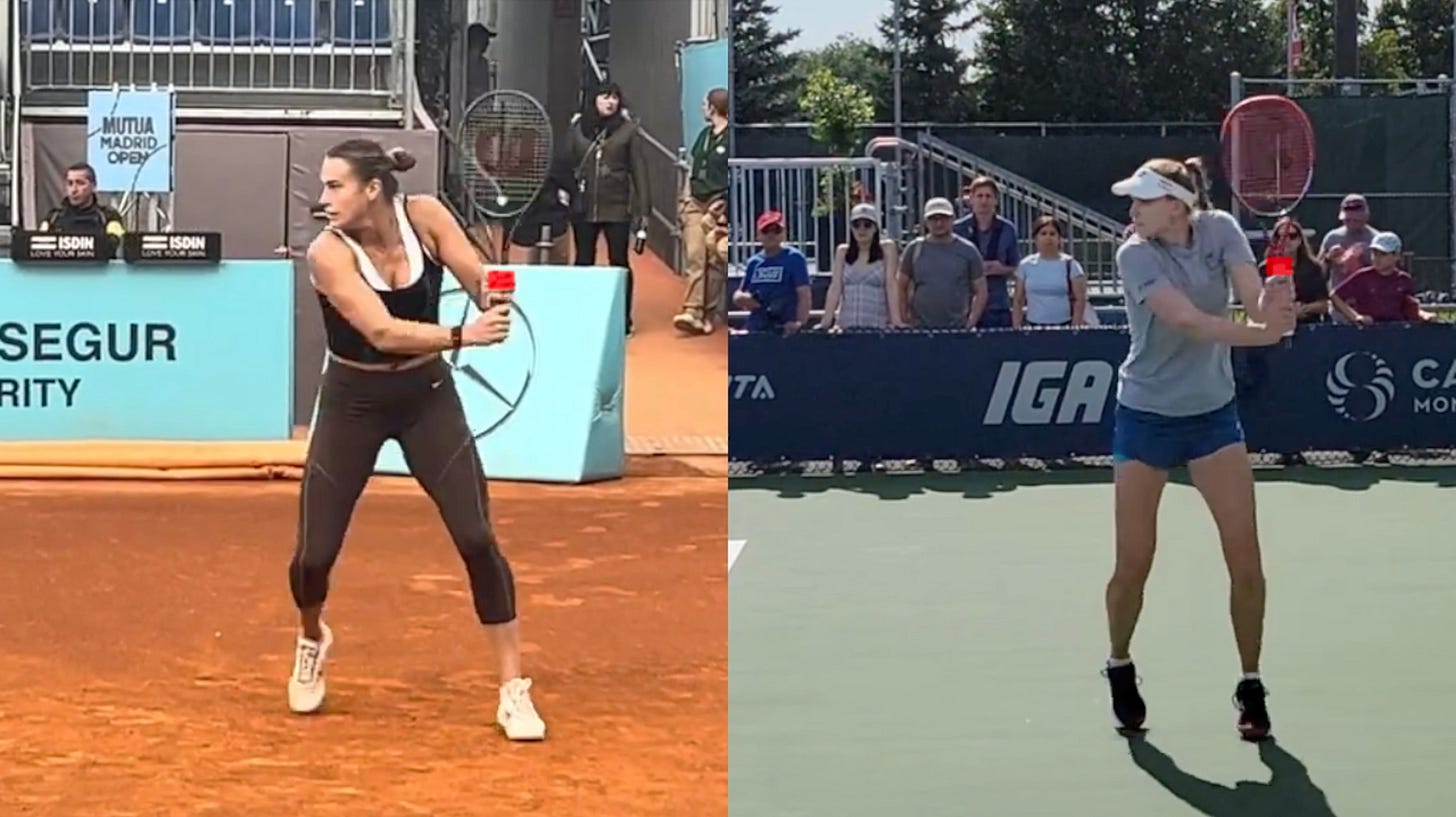
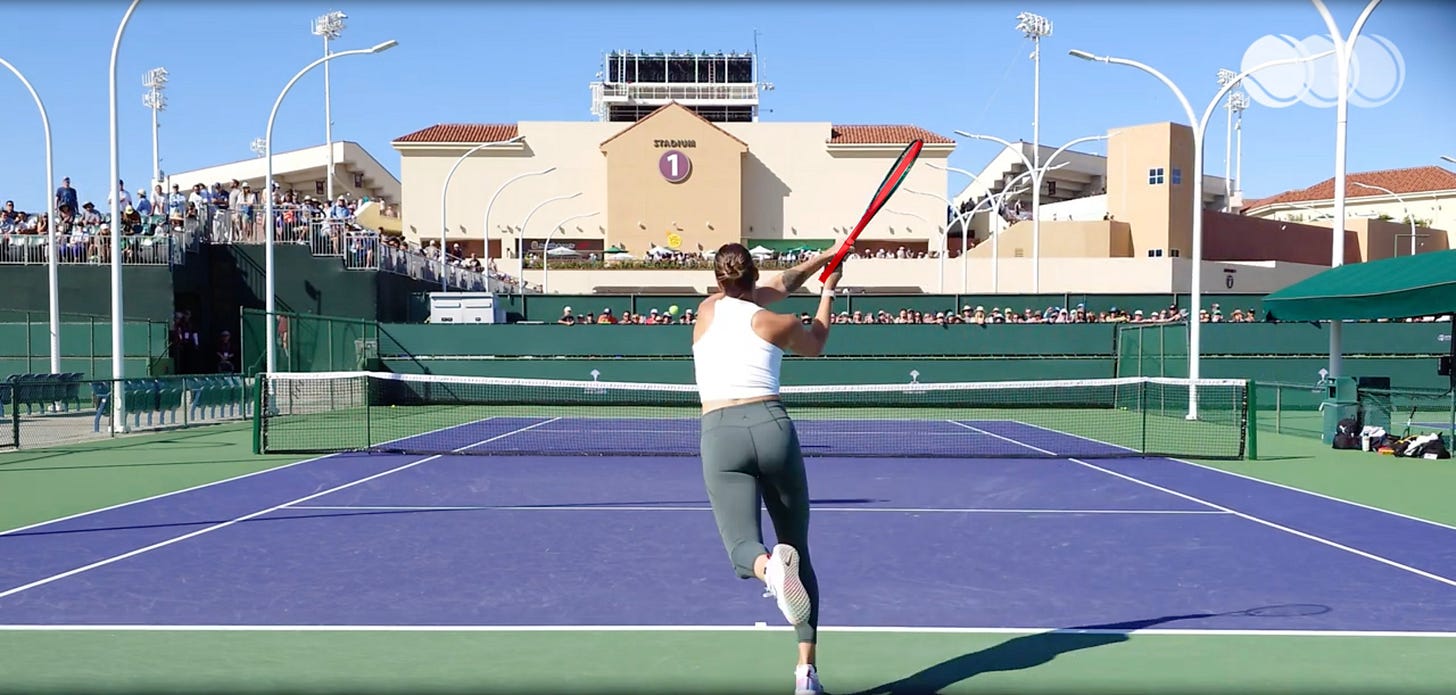






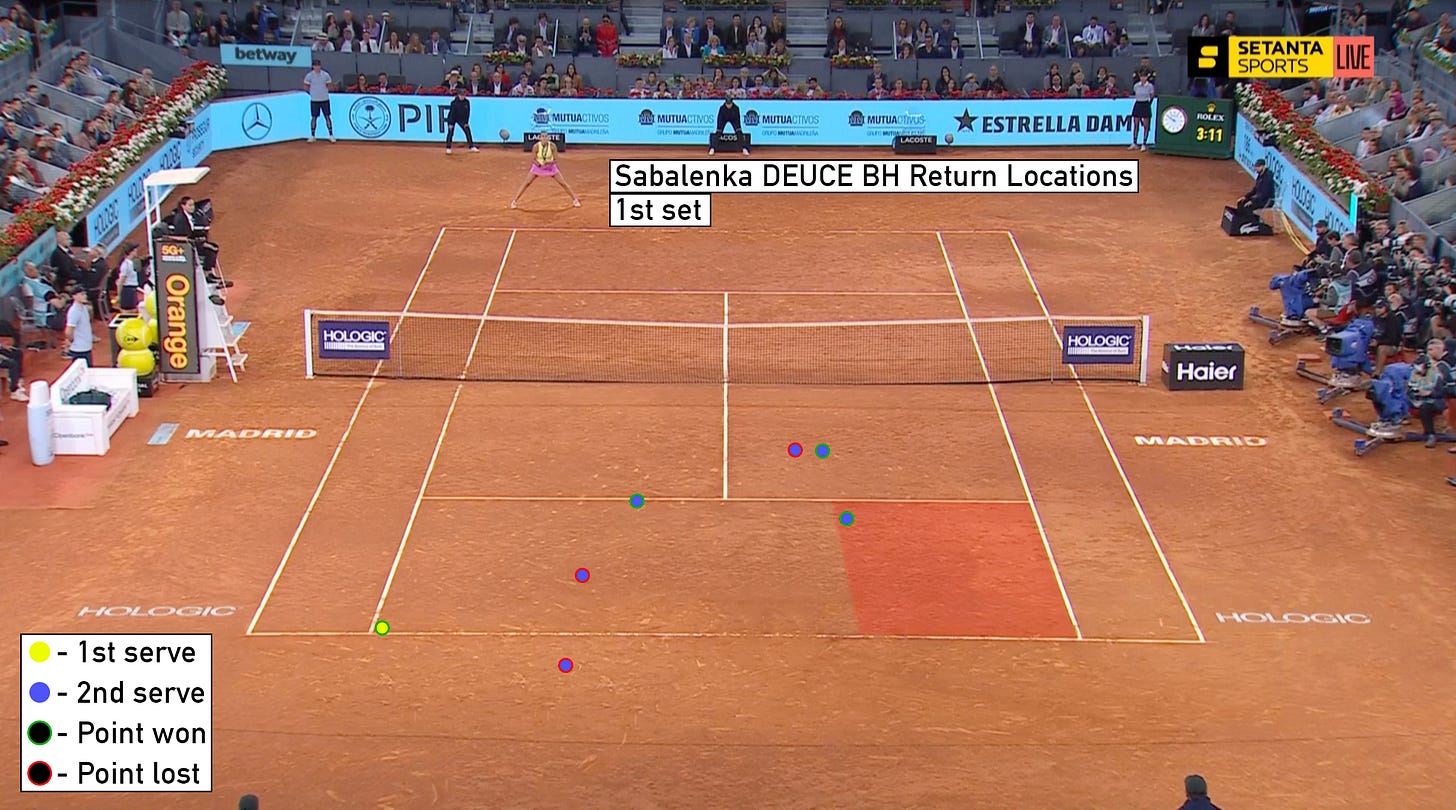



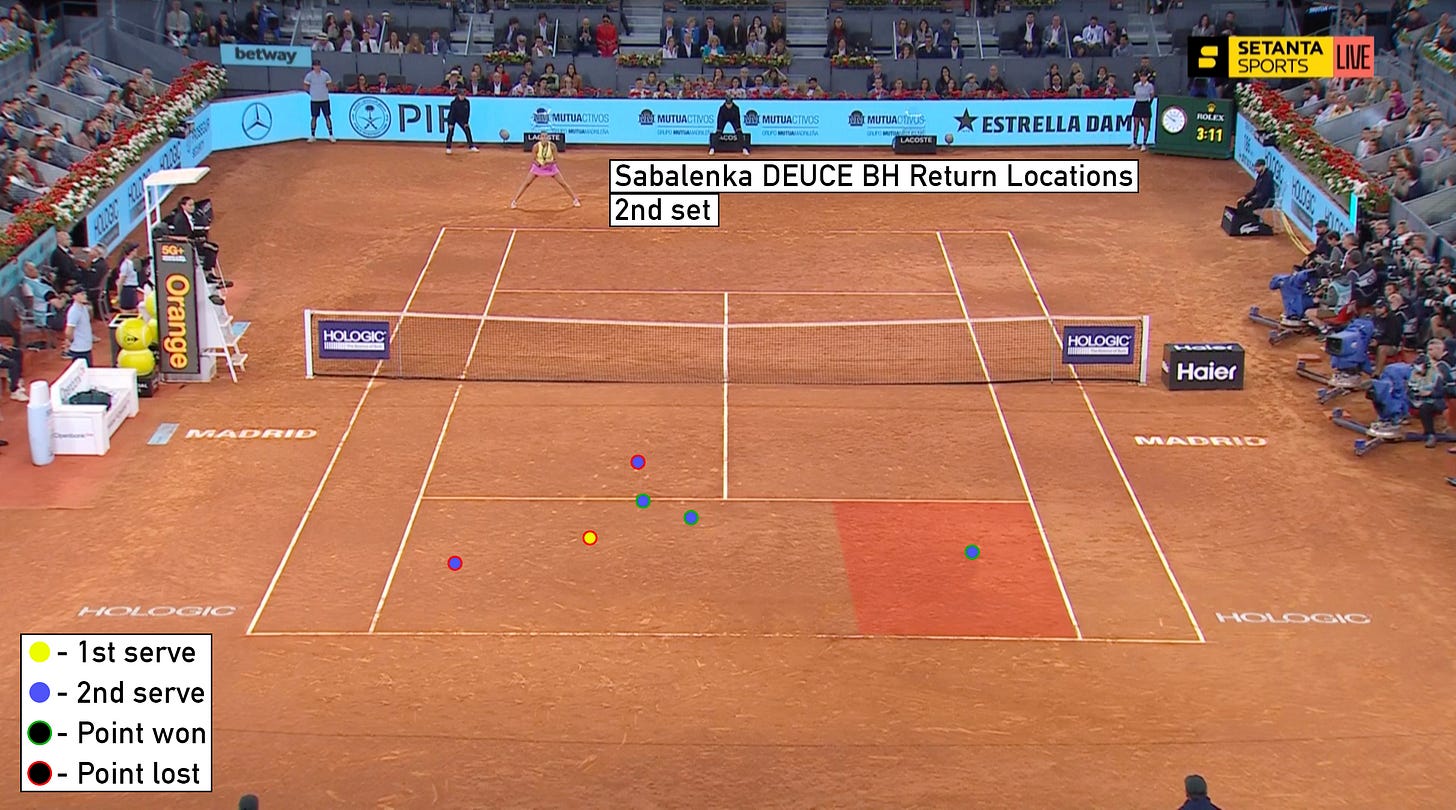
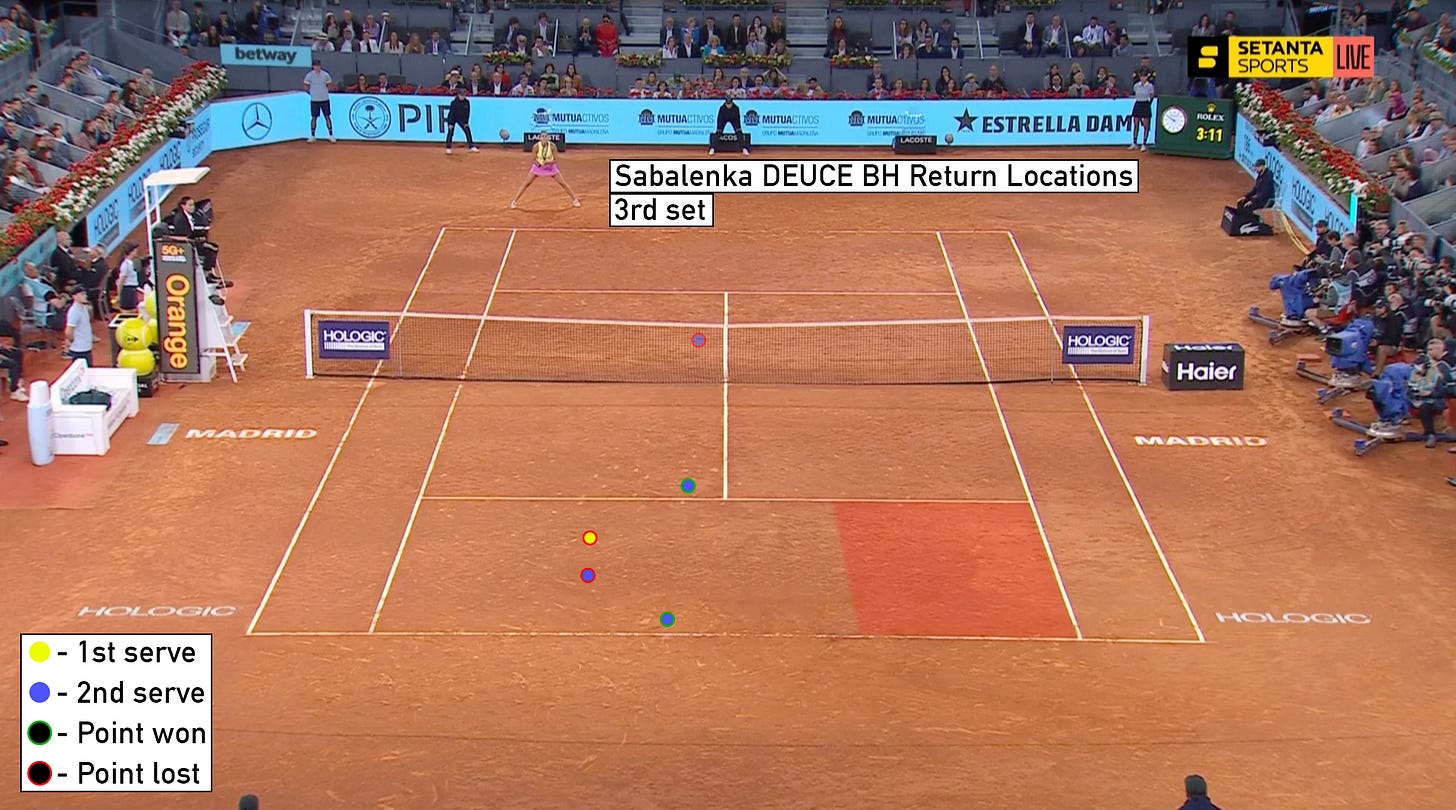



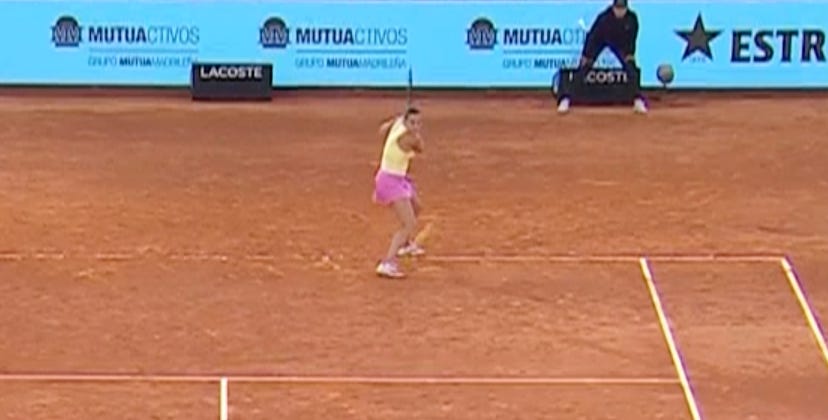
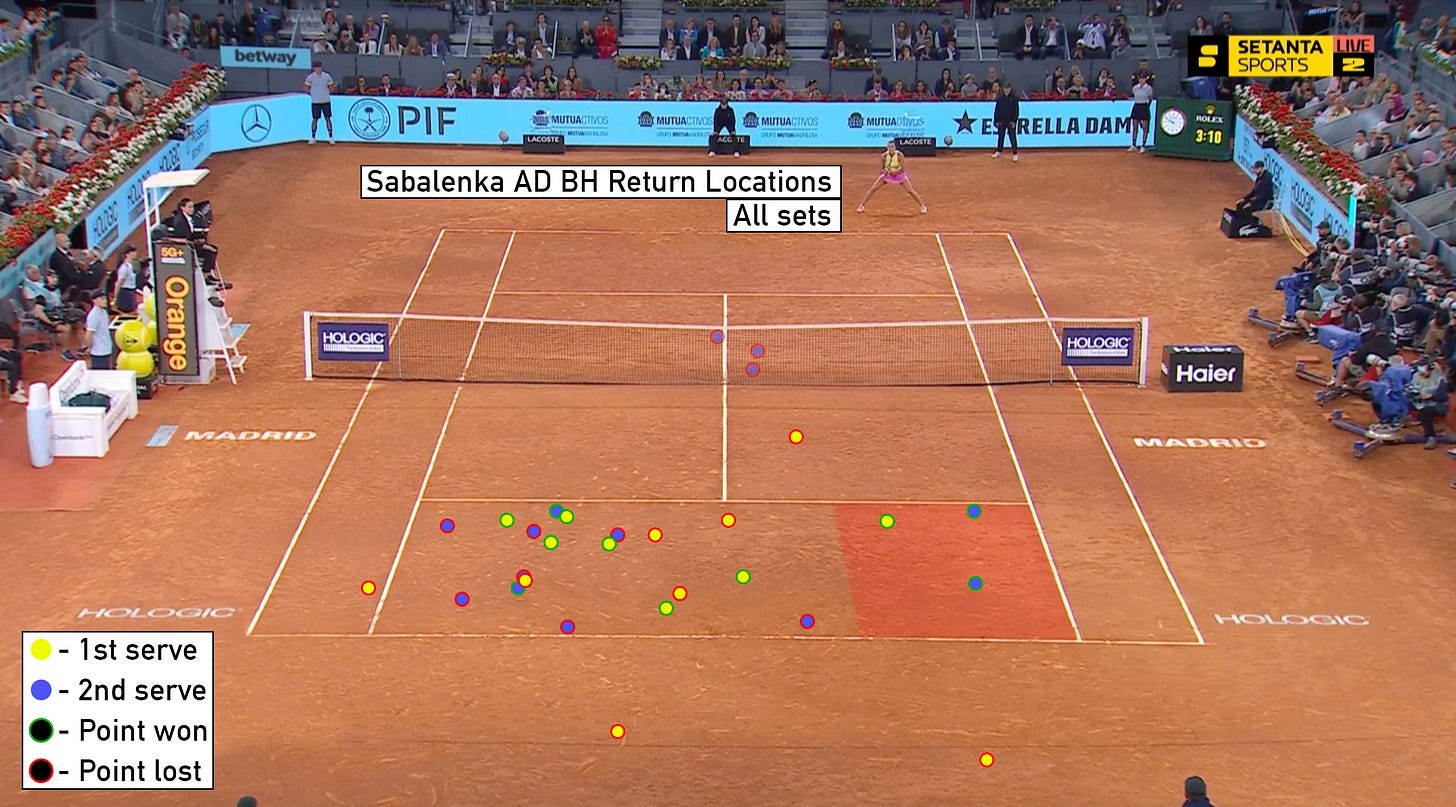

Wonderful, insightful piece, thank you! Dubrov should contact you asap!
To emphasize your point that Swiatek was happy to play Serve+1 BHs behind 2nd serves, these were her numbers (only includes 2nd serve points):
Serve+1 distribution: 40% FH; 60% BH (12;18)
Won after a Serve+1 FH: 25% (3/12)
Won after a Serve+1 BH: 61% (11/18)
Swiatek did a great job at defending her 2nd serve.
Obviously, Sabalenka failed to come up with a response. Her numbers were uncharacteristic and poor: a single forcing return (and no winners) while missing 7 2nd serve returns.